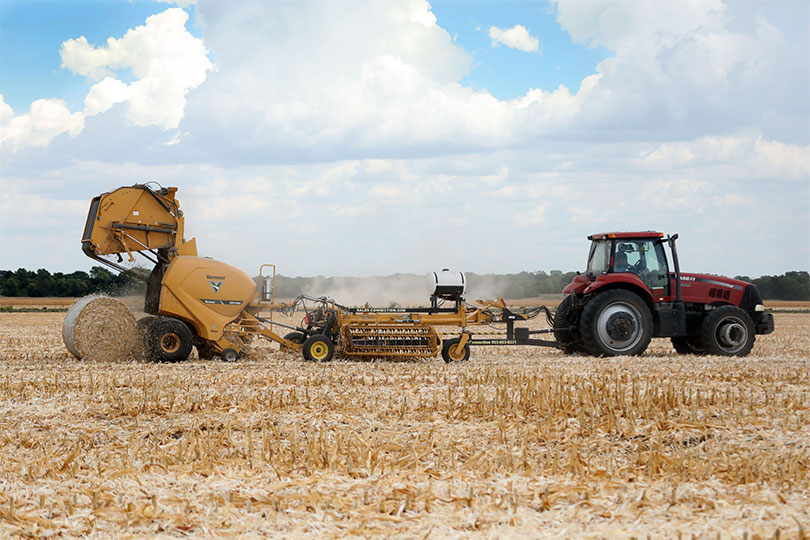By Julie Tomascik
Editor
Months of drought conditions have left pastures bare, and what hay can be found is expensive. Add other high feed and fuel prices due to inflation, and ranchers are facing a tough outlook.
Part of the solution for many looking for hay is this year’s corn crop.
“We’re short on grass this year and having trouble filling hay orders,” said Kent Willmott, a young hay farmer from Anderson County. “We’re baling corn stalks to just try to give people an option to be able to keep their cows, keep them fed and not have to liquidate their herds.”
Willmott and other hay farmers in mid-August were baling corn stalks behind grain farmer Braden McInnis as his crew harvested the corn crop.
“We’ve had guys with balers waiting for us to get the combines out of the field,” McInnis said. “They’re moving it as quick as they can. It’s just crazy to see that demand for corn stalks.”
At one point, McInnis said nine balers were running in the field behind the combines. There were some breakdowns, though.
But it’s part of the hay business, especially when baling corn stalks.
“Grass hay is more convenient to bale and a little easier on your equipment,” Willmott said. “We tried to really cover some ground and make some progress, but you have breakdowns. You just have to keep going.”
And while combines were harvesting and balers were running, truckers were also in the field. Thanks to the drought declaration issued by Governor Greg Abbott, vehicle size and weight requirements were suspended for operators of commercial vehicles to travel in and through the Lone Star State for agricultural activities.
Many are making deliveries straight to ranchers who are feeding corn stalks right away, hoping to keep what grass hay they have for later in the year.
Saving stored feedstuffs and hay for winter feed is necessary to make it through a drought. Late August rains, however, helped places like Anderson County. The area received eight to 11 inches of rain, but other parts of the state received significantly less or none at all.
So, corn stalk bales can help ranchers stretch what hay they do have.
“This is unusual for us. It’s usually not a crop that’s particularly wanted, but this year, it’s something that at least gives you an option other than having to sell your cattle,” Willmott said. “A lot of them are happy just to have anything. We’re getting them something to allow them to hold on just a little bit longer. I think people are pretty grateful to have it.”
About 15,000 bales—5×4 feet in size—were made, and most of them already had a destination.
“We’re shipping to some of our normal customers,” said Willmott, who supplies hay to a large feed store chain with about 100 locations north of Anderson County. “And then we’re shipping west and south of here.”
Truckloads of corn stalk bales, like the ones from Anderson County, can be seen along highways and farm to market roads, winding their way to pastures and dairies.
The demand for hay is high, and the supply is short.
“This is a good, cheap source for forage. It’s not a save all, but if you can supplement it with liquid feed or some good grass or some other type of feed, it’ll stretch it,” McInnis said. “I think that’s all people are doing with this—trying to get by and make it work.”
Willmott tested the protein in the corn stalk bales.
“They tested about 7% protein. It exceeded my expectations,” he said. “We’re trying to keep them clean. We’re trying to rake high and keep that ash content down and make as good of a product out of a bad situation as we can.”
Making the best out of a tough situation—it’s what farmers do.
“We knew coming into this year, prior to even knowing how bad the drought would be, that it was going to be a tough year with fuel and inflation the way they are. So, the drought on top of that was just kind of a triple threat,” Willmott said.
But they’ll do what they can to make it through the year, and hope that next year is better.
Although it was more than they needed, the rain was welcomed in Anderson County.
“Maybe we’ll get some grazing out of some winter pastures or some fall pastures planted and get them up and growing,” Willmott said.

